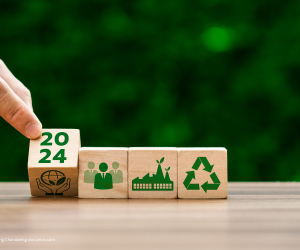
In today’s volatile economic landscape, understanding the intricate relationship between interest rates, inflation, and real estate investments is more crucial than ever. This blog aims to share knowledge about the impact of interest rate hikes and inflation on real estate investments, particularly focusing on the Asia-Pacific region, a burgeoning market for real estate investments.
The Rise of Inflation and Interest Rates: A Global Perspective
Let us begin by understanding the global economic indicators that are shaping real estate investments. Inflation and interest rates are two economic indicators that are profoundly connected with the real estate market. A rise in these rates often leads to increased borrowing costs and lower property values. In 2022, the global real estate investment landscape experienced a subtle yet significant shift. According to recent data compiled by ANREV, global capital raising for non-listed real estate investments eased to $264 billion, marking an 8% decline from the previous year. This downturn is attributed to prevailing uncertainties stirred by rising inflation and interest rates.
However, it is crucial to note that the Asia Pacific region bucked this trend. Capital inflow from Asia Pacific investors surged by 6% to $54.8 billion, solidifying the region’s position as a dominant component of the global real estate capital market. In stark contrast, European investors pulled back, with capital raised from them plummeting by 43% to $47 billion. This divergence underscores the complex interplay of macroeconomic and behavioural factors affecting real estate investments globally.
The Asia-Pacific Perspective
Contrary to global trends, the Asia-Pacific region has shown remarkable resilience. It indicates strong investor confidence in the Asia-Pacific real estate market despite global economic uncertainties. The ANREV study suggests that investors in the Asia-Pacific region are increasingly opting for joint ventures and club deals, which accounted for 25% of the capital allocated to APAC strategies. This shift suggests that investors are seeking more control and strategic involvement in their investments.
Investment Styles and Fund Structures
Interest in Higher Risk
Different investment styles offer varying levels of risk and reward for each investor. Core funds were attracting 45% of the total capital raised in the Asia-Pacific region in 2022. Riskier investment styles like opportunistic funds and value-added funds were gaining traction, accounting for the remaining 55%. This diversification in investment styles suggests that investors are exploring multiple avenues to maximize returns and mitigate the risks involved.
Changes in Asset Class
Different asset classes respond uniquely to interest rate shifts. The Industrial and Logistics sectors were emerging as the preferred asset classes, attracting 69% of the capital raised for single-sector strategies in the Asia-Pacific region in 2022. This trend indicates a strong investor preference for these sectors, due to their resilience to economic fluctuations.
The Multifaceted Impacts
Interest rates and inflation have a direct impact on the cost of borrowing and the real returns on investment in several ways:
Cost of Borrowing
When interest rates are high, the cost of borrowing increases for real estate developers and investors. This can lead to a reduction in new projects and investments, affecting the overall real estate market.
Reduced Returns
High inflation can erode the real returns on investment. For instance, if the inflation rate is higher than the rate of return on an investment, the real value of the investment diminishes over time.
Uncertainty
Fluctuating interest rates and inflation can create an environment of economic uncertainty. This makes it difficult for investors to forecast future costs and returns accurately, leading to hesitation in deploying capital.
Asset Valuation
Inflation can distort the valuation of real estate assets. High inflation may nominally inflate asset values, while high interest rates may lead to lower valuations, making it challenging for investors to assess the true value of their investments.
Liquidity Constraints
High interest rates can lead to lower liquidity in the market. Banks consider an increased repayment risk and lend less. This can make it difficult for investors to exit their positions without incurring losses.
Capital Allocation
With high inflation and interest rates, investors may seek alternative investment avenues like Treasury bonds or commodities, which can offer better returns with lower risk, thereby reducing the capital available for real estate investments.
Adapting to the Evolving Real Estate Investment Climate in Asia-Pacific
The real estate investment landscape is undergoing significant changes due to fluctuations in interest rates and inflation. While the Asia-Pacific region has shown resilience, investors must be well-informed and adaptable. Understanding these economic indicators and their impact on different asset classes can provide investors with the insights needed to navigate this complex market successfully.
Start your Real Estate Investing Journey with SafeRE
SafeRE has created a revolution in providing direct access to quality real estate investments by reducing fees and offering a seamless and transparent investment process. SafeRE platform provides access for investors to funds that exhibit steady performance over the years. SafeRE constantly introduces more efficient ways to build your wealth through a selected range of quality investments. For more information on investment opportunities, feel free to reach out to us or directly access your account on the SafeRE platform.
Disclaimer: This is not an advertisement making an offer or calling attention to an offer or intended offer. The information contained herein is for informational purposes only and has not been independently verified to ensure its accuracy and fairness. Nothing in this content material should be relied upon as a representation or warranty as to the future. In considering any investment or other performance contained herein, investors should bear in mind that past performance is no guarantee of future results and should consult their respective advisors.
Neither this article nor anything contained herein shall form the basis of any contract or commitment whatsoever should not form the basis of any investment decision and should not be considered as advice or recommendation by SafeRE, its affiliates, representatives, directors, managers officers, employees, agents, to acquire any investment products. This article is confidential and may not be copied, distributed, or reproduced in any form for any purposes without prior consent provided by SafeRE.



